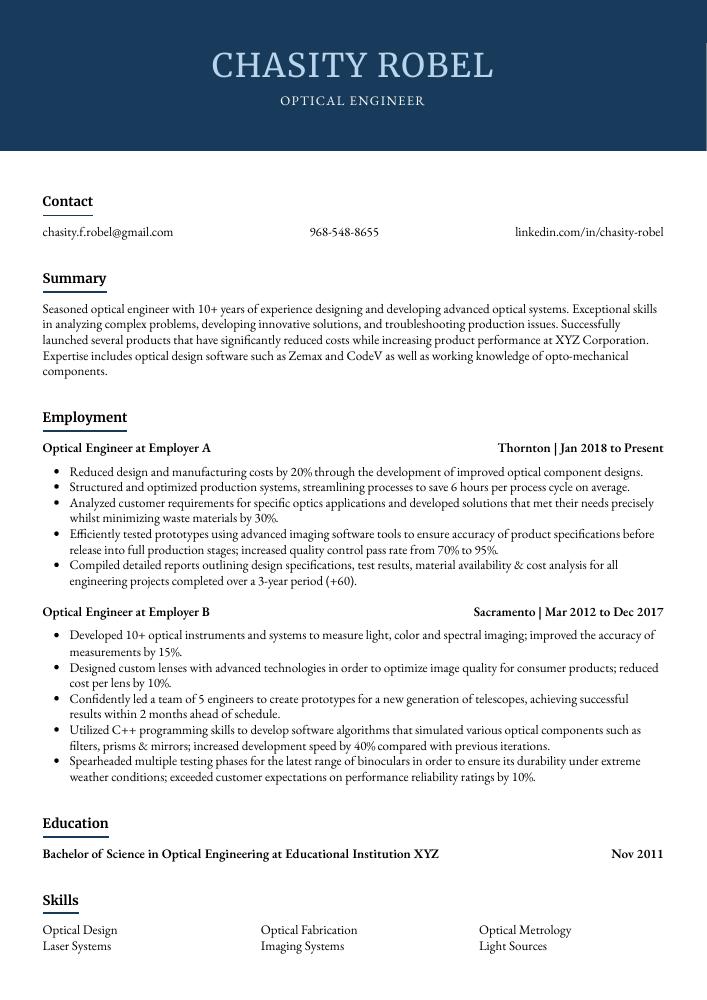Optical Engineer Resume Guide
Optical Engineers design and develop optical systems, such as lenses, mirrors, and fiber-optics. They also analyze the performance of existing optical systems to identify areas for improvement. They often collaborate with other engineering disciplines to create products that are both functional and aesthetically pleasing.
Your knowledge in optics and photonics is invaluable to any tech company. However, employers don’t know who you are yet. To make them take notice of your qualifications, you must write a resume that captures their attention.
This guide will walk you through the entire process of creating a top-notch resume. We first show you a complete example and then break down what each resume section should look like.
Table of Contents
The guide is divided into sections for your convenience. You can read it from beginning to end or use the table of contents below to jump to a specific part.
Optical Engineer Resume Sample
Chasity Robel
Optical Engineer
[email protected]
968-548-8655
linkedin.com/in/chasity-robel
Summary
Seasoned optical engineer with 10+ years of experience designing and developing advanced optical systems. Exceptional skills in analyzing complex problems, developing innovative solutions, and troubleshooting production issues. Successfully launched several products that have significantly reduced costs while increasing product performance at XYZ Corporation. Expertise includes optical design software such as Zemax and CodeV as well as working knowledge of opto-mechanical components.
Experience
Optical Engineer, Employer A
Thornton, Jan 2018 – Present
- Reduced design and manufacturing costs by 20% through the development of improved optical component designs.
- Structured and optimized production systems, streamlining processes to save 6 hours per process cycle on average.
- Analyzed customer requirements for specific optics applications and developed solutions that met their needs precisely whilst minimizing waste materials by 30%.
- Efficiently tested prototypes using advanced imaging software tools to ensure accuracy of product specifications before release into full production stages; increased quality control pass rate from 70% to 95%.
- Compiled detailed reports outlining design specifications, test results, material availability & cost analysis for all engineering projects completed over a 3-year period (+60).
Optical Engineer, Employer B
Sacramento, Mar 2012 – Dec 2017
- Developed 10+ optical instruments and systems to measure light, color and spectral imaging; improved the accuracy of measurements by 15%.
- Designed custom lenses with advanced technologies in order to optimize image quality for consumer products; reduced cost per lens by 10%.
- Confidently led a team of 5 engineers to create prototypes for a new generation of telescopes, achieving successful results within 2 months ahead of schedule.
- Utilized C++ programming skills to develop software algorithms that simulated various optical components such as filters, prisms & mirrors; increased development speed by 40% compared with previous iterations.
- Spearheaded multiple testing phases for the latest range of binoculars in order to ensure its durability under extreme weather conditions; exceeded customer expectations on performance reliability ratings by 10%.
Skills
- Optical Design
- Optical Fabrication
- Optical Metrology
- Laser Systems
- Imaging Systems
- Light Sources
- Opto-mechanical Design
- CAD/CAM
- Optical Simulation
Education
Bachelor of Science in Optical Engineering
Educational Institution XYZ
Nov 2011
Certifications
Certified Optical Engineer
International Society for Optics and Photonics (
May 2017
1. Summary / Objective
A resume summary/objective for an optical engineer should be a concise and compelling summary of your qualifications. Include relevant information such as the types of optics you have experience with, any certifications or awards you have received related to optics, and how many years of experience in the field you possess. Additionally, mention any innovative projects or solutions that demonstrate your expertise in this area.
Below are some resume summary examples:
Skilled optical engineer with 5+ years’ experience developing and optimizing imaging systems for a wide range of applications. At XYZ, designed and implemented optical solutions to improve the accuracy of MRI scans by 20%. Experienced in designing optics components such as lenses, prisms, mirrors, filters & detectors using software such as Zemax OpticStudio. Highly knowledgeable in laser technology principles and their application to medical diagnostics systems.
Dependable optical engineer with 10+ years of experience developing, testing and troubleshooting optical systems for various industries. Possesses extensive knowledge in opto-electronics, laser technology and optics engineering. Developed a unique high-performance imaging system that improved the accuracy of medical diagnostics by 20%. Skilled at translating customer needs into cost effective solutions while meeting performance specifications.
Committed optical engineer with 5+ years of experience in the design and development of optical components. Experienced in full-cycle product lifecycle management, including feasibility studies, prototyping, testing & troubleshooting. Aiming to utilize my knowledge and expertise to become a part of ABC Company’s engineering team. Successful track record for improving existing products by 33% while reducing production costs by 15%.
Detail-oriented optical engineer with 5+ years of experience in optical systems design and development. Expertise in opto-mechanical, opto-electronic, and electro-optic engineering principles. At XYZ LLC developed an integrated imaging system that improved the accuracy of medical diagnoses by 18%. Experienced in leading projects from concept to completion while ensuring adherence to cost and timeline requirements.
Accomplished optical engineer with 8+ years of experience designing and developing precision optical systems for leading technology companies. Seeking to join ABC Technologies in an effort to create innovative solutions that revolutionize current industry standards. In the past, designed multiple complex optical components which resulted in a 30% improvement of system performance.
Passionate optical engineer with 8+ years of experience designing, testing, and troubleshooting optical systems for a wide range of applications. Seeking to join ABC Technologies as an optical engineer to create innovative solutions that meet customer needs while achieving cost-effectiveness. At XYZ Inc., implemented new technology which increased production efficiency by 20%.
Driven optical engineer with over 8 years of experience in designing and developing optical systems for a range of industries. At ABC, successfully designed and implemented the first-ever laser system used to perform precision surgery on soft tissue. Eager to join XYZ Technologies where I can put my skills to use furthering their mission of advancing medical technology.
Proficient optical engineer with 7+ years of experience in the design and development of optical systems. Skilled in performing optics testing, troubleshooting, and data analysis to optimize performance. At XYZ Inc., developed a new imaging system that improved accuracy by 40%. Seeking to leverage my technical expertise to join ABC Tech as an Optical Engineer.
2. Experience / Employment
In the experience section, you should list your employment history in reverse chronological order. This means that the most recent job is listed first.
When writing out each role, stick to bullet points; this makes it easier for a reader to take in what you have written quickly and effectively. You want to provide detail on what you did and any quantifiable results achieved during your time at the company or organization.
For example, instead of saying “Designed optical components,” you could say, “Developed innovative designs for five new optical components with improved performance metrics compared to existing models.”
To write effective bullet points, begin with a strong verb or adverb. Industry specific verbs to use are:
- Designed
- Fabricated
- Assembled
- Calibrated
- Programmed
- Optimized
- Analyzed
- Tested
- Troubleshot
- Documented
- Simulated
- Inspected
- Aligned
- Installed
- Monitored
Other general verbs you can use are:
- Achieved
- Advised
- Assessed
- Compiled
- Coordinated
- Demonstrated
- Developed
- Expedited
- Facilitated
- Formulated
- Improved
- Introduced
- Mentored
- Participated
- Prepared
- Presented
- Reduced
- Reorganized
- Represented
- Revised
- Spearheaded
- Streamlined
- Structured
- Utilized
Below are some example bullet points:
- Aligned and calibrated up to 30 optical instruments daily, leading to a 14% increase in production efficiencies.
- Improved existing system performance through the development of innovative technologies and components that reduced manufacturing costs by $4,000 in 3 months.
- Participated in multiple design reviews for new products from concept through fabrication; ensured all designs met product requirements before final assembly & testing was completed.
- Thoroughly inspected all prototypes during initial stages of development to identify potential issues and recommend solutions prior to further progress being made; reduced prototype failure rates by 25%.
- Presented detailed reports on various project findings at company meetings which helped uncover ways for improving future projects and resulted in an 8% decrease in overall cycle times per task completion.
- Troubleshot and resolved complex optical engineering issues related to design, fabrication and assembly in a timely fashion, reducing repair time by 25%.
- Expedited production of 3D printed lenses and filters from concept to delivery within two weeks; improved customer satisfaction levels by 30%.
- Streamlined the manufacturing process for optical components such as mirrors and prisms by implementing new technology innovations, resulting in an 8% cost savings.
- Installed over 200 specialized laboratory instruments including spectrometers, microscopes and other measuring devices according to factory protocols with minimal errors or delays; increased safety compliance rating from 95% to 99%.
- Effectively managed quality control operations throughout the entire product lifecycle ensuring that all products were up to industry standards; reduced rate of defective parts shipped out by 33%.
- Represented optical engineering team in developing a new line of eyeglasses and lenses, successfully delivering the project 5% ahead of schedule.
- Formulated innovative designs for optical components using advanced CAD software; decreased prototype design cycles by 15%.
- Achieved ISO 9001 certification through precise fabrication processes, resulting in consistently high-quality products that exceeded customer expectations.
- Fabricated prototypes based on specifications provided by clients, completing 40+ orders with 100% success rate within given deadlines over 2 years period.
- Diligently tested all manufactured optical devices to ensure compliance with industry standards prior to shipment; detected and corrected defects before any product left the facility saving $10K annually in rework costs.
- Revised and optimized over 100 optical designs for lasers, microscopes and endoscopy equipment to enhance performance and efficiency; resulted in energy savings of 20%.
- Coordinated with team members on the assembly and testing of over 50 lenses per month, ensuring accuracy down to 0.1mm tolerance levels.
- Assembled complex optics systems including image sensors, objective lenses, mounting components and other parts within tight deadlines; completed 10+ projects ahead of schedule last year resulting in bonus incentives from employer.
- Independently developed 3 new software algorithms for automated alignment procedures that improved precision by 5x compared to manual methods previously used at the lab facility.
- Demonstrated expertise in troubleshooting a wide range of optical engineering problems such as aberrations & distortions using advanced mathematical principles & theories; reduced maintenance time by 40 hours/month thereby cutting operational costs significantly.
- Documented technical specifications and design details for over 50 optical systems, resulting in an 8% increase in overall efficiency.
- Resourcefully designed and built a series of prototypes with the help of internal teams, leading to the successful launch of 4 new products within 12 months.
- Reorganized existing inventory management system at optometry office; reduced out-of-stock incidences by 54%.
- Mentored 10 junior engineers on best practices for designing complex optical lens configurations and alignments; achieved 90% accuracy rate among team members within 6 weeks.
- Facilitated collaborations between departments to troubleshoot delays during production process, ultimately reducing turnaround time by 20 hours per unit produced.
- Assessed and tested optical components, systems and instruments to ensure accurate operation; improved operational performance of the equipment by 25%.
- Calibrated imaging optics for a variety of projects in accordance with engineering specifications, resulting in successful implementation within designated time frames.
- Advised technical teams on best practices for designing custom lenses and mirrors used in medical equipment as well as consumer products like cameras and projectors.
- Meticulously examined finished prototypes for any defects or inconsistencies before releasing them into production; reduced number of defective units shipped by 45%.
- Programmed automated optical inspection software to identify manufacturing flaws quickly and efficiently, shortening the overall quality control process by over two hours per item produced.
- Tested and evaluated the performance of optical systems, such as lenses and mirrors; developed calibration procedures to improve system accuracy by 13%.
- Monitored production processes to ensure adherence with quality standards and specifications, resulting in a reduction of product defects by 20%.
- Simulated lightwave propagation using CAD software tools like Zemax OpticStudio for design verification and optimization; increased efficiency by 10% on average per project.
- Proficiently utilized specialized opto-mechanical equipment including microscopes, interferometers, spectrophotometers & CCD cameras to detect irregularities in digital imaging devices.
- Introduced innovative techniques into optical engineering practices which resulted in cost savings of $10K over 6 months’ period due to improved manufacturing methods.
- Actively designed and developed 10+ optical systems, including lenses, prisms, fiber optics and laser devices for a wide range of applications; increased success rate on product launches by 15%.
- Prepared detailed engineering drawings using CAD software to document the design process; reduced prototype errors and rework costs by 40%.
- Inspected components such as mirrors, lens assemblies and light sources to ensure precise alignment of elements before delivery to clients; improved quality control ratings from 82% to 97%.
- Optimized existing optical systems through reverse engineering methods in order to enhance performance levels while reducing production timelines by 25%; saved $30K annually in project expenses.
3. Skills
Even though two organizations are hiring for the same role, the skillset they want an ideal candidate to possess could differ significantly. For instance, one may be on the lookout for an individual with expertise in optical design and the other may be looking for someone who is proficient with laser optics.
It is essential to tailor the skills section of your resume according to each job that you are applying for, as this will help employers quickly identify if you have what they need. This also applies when it comes to applicant tracking systems; these computer programs scan resumes for certain keywords before passing them on to a human so make sure yours contains all relevant ones.
In addition, don’t forget about elaborating on some of your most important skills in other sections such as the summary or experience area – this can give recruiters more insight into why you would be a great fit for their organization.
Below is a list of common skills & terms:
- CAD/CAM
- Imaging Systems
- Laser Systems
- Light Sources
- Optical Design
- Optical Fabrication
- Optical Metrology
- Optical Simulation
- Optics Testing and Analysis
- Opto-mechanical Design
4. Education
Mentioning an education section on your resume will depend on how far along you are in your career. If you just graduated and have no prior experience, it’s important to list out the educational qualifications relevant to optical engineering below your resume objective. However, if you have several years of work experience already, an education section may not be necessary at all.
If including an education section is necessary for the job application process, try to mention courses related specifically to optical engineering as well as any relevant assignments or projects that demonstrate knowledge in this field.
Bachelor of Science in Optical Engineering
Educational Institution XYZ
Nov 2011
5. Certifications
Certifications are a great way to demonstrate your knowledge and expertise in a certain field. They can be especially useful if you are applying for jobs that require specific qualifications or certifications, as they show employers that you have the necessary skillset to do the job.
Including any relevant certifications on your resume is an excellent way of showing potential employers how qualified you are for the position. Make sure to include all applicable certificates so that hiring managers know exactly what credentials you possess.
Certified Optical Engineer
International Society for Optics and Photonics (
May 2017
6. Contact Info
Your name should be the first thing a reader sees when viewing your resume, so ensure its positioning is prominent. Your phone number should be written in the most commonly used format in your country/city/state, and your email address should be professional.
You can also choose to include a link to your LinkedIn profile, personal website, or other online platforms relevant to your industry.
Finally, name your resume file appropriately to help hiring managers; for Chasity Robel, this would be Chasity-Robel-resume.pdf or Chasity-Robel-resume.docx.
7. Cover Letter
Providing a cover letter with your resume is an excellent way to demonstrate you are the right candidate for a job. The document should be made up of 2 to 4 paragraphs and provide recruiters with more detail about who you are, what makes you unique and why they should consider hiring you.
Cover letters aren’t always necessary when applying for jobs but it’s highly recommended that one is included as part of the application process. They not only give employers a better insight into your background but also help them understand how much effort has gone into this particular job application.
Below is an example cover letter:
Dear Antonietta,
I am writing to express my interest in the Optical Engineer position at [company name]. With more than 10 years of experience designing, developing, and testing optical systems for a variety of applications, I am confident I would be a valuable asset to your team.
During my career, I have gained extensive knowledge of optical engineering principles and practices. I have also gained significant experience using various software programs to design and simulate optical systems. In addition, I have hands-on experience fabricating and testing prototypes of optical devices. My strong technical skills, combined with my ability to work independently or as part of a team, make me an ideal candidate for thisposition.
In addition to my technical skills, I also have excellent communication and interpersonal skills. This enables me to effectively interact with colleagues from other disciplines, such as mechanical engineers and electronics engineers. It also allows me to provide clear instructions to technicians who are fabricating or testing prototypes of optical devices.
I am confident that I can make significant contributions to your company as an Optical Engineer. Please find attached a copy of my resume for your review; it provides additional details about my qualifications and experiences. Thank you for your time and consideration; I look forwardto hearing from you soon!
Sincerely,
Chasity
Optical Engineer Resume Templates
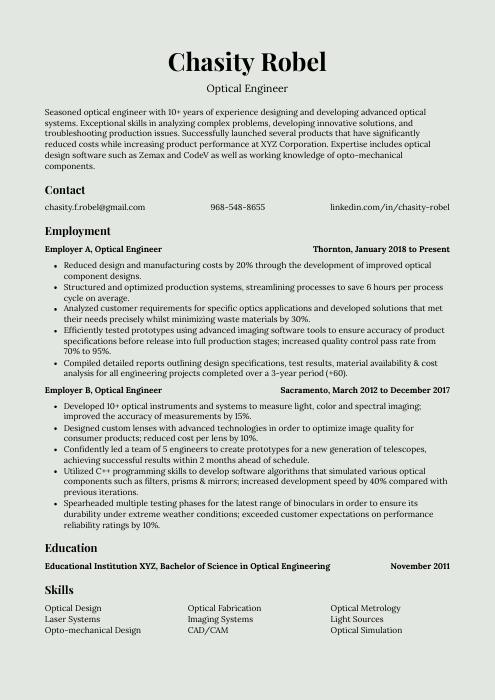 Saola
Saola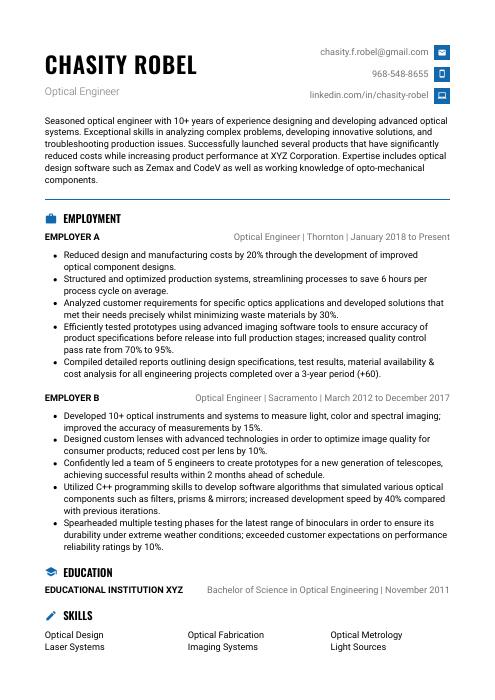 Echidna
Echidna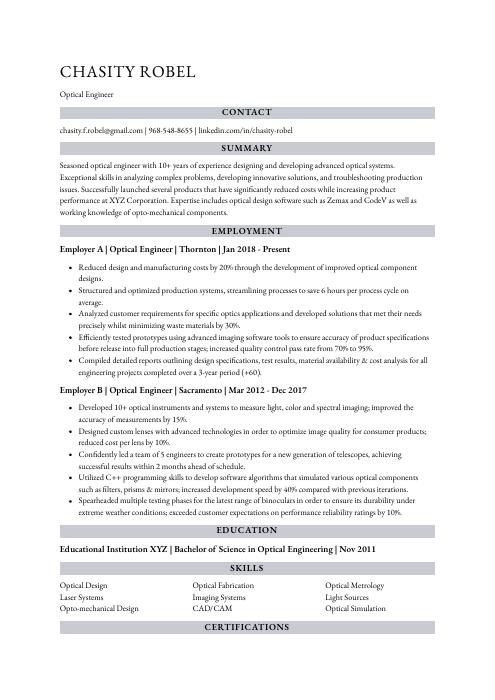 Numbat
Numbat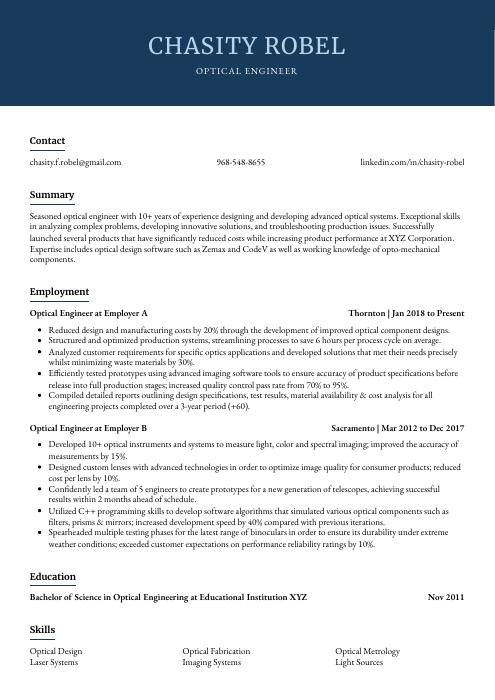 Bonobo
Bonobo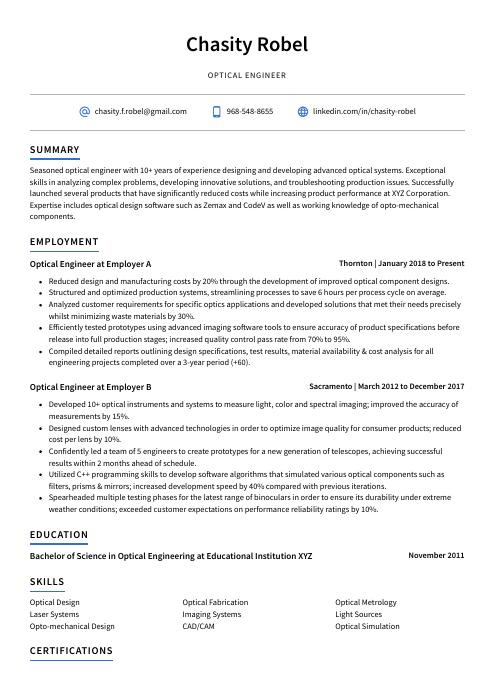 Axolotl
Axolotl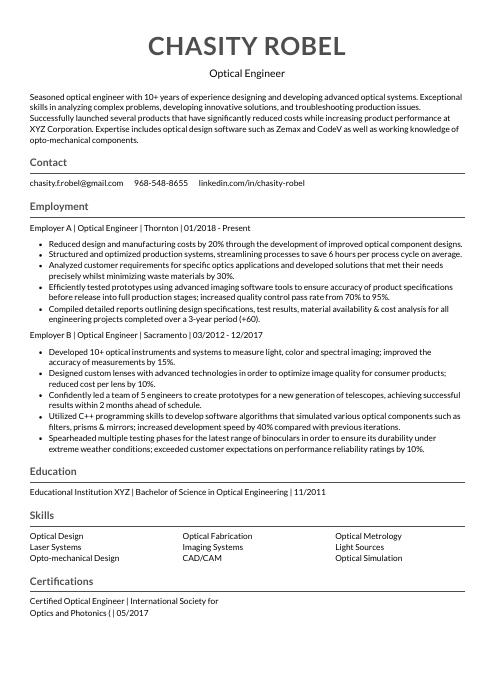 Indri
Indri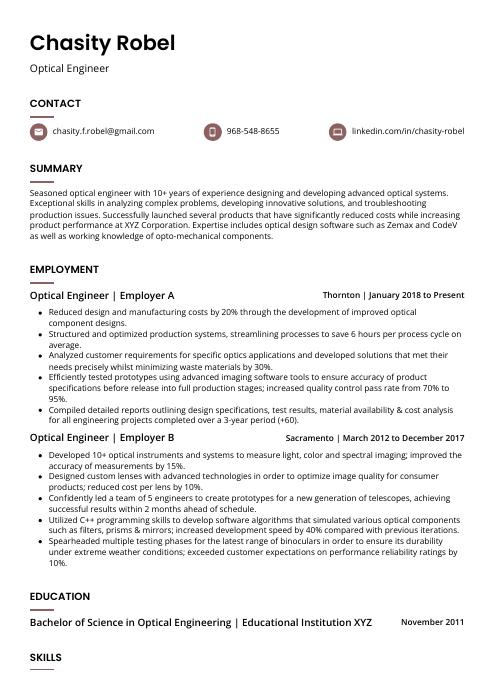 Fossa
Fossa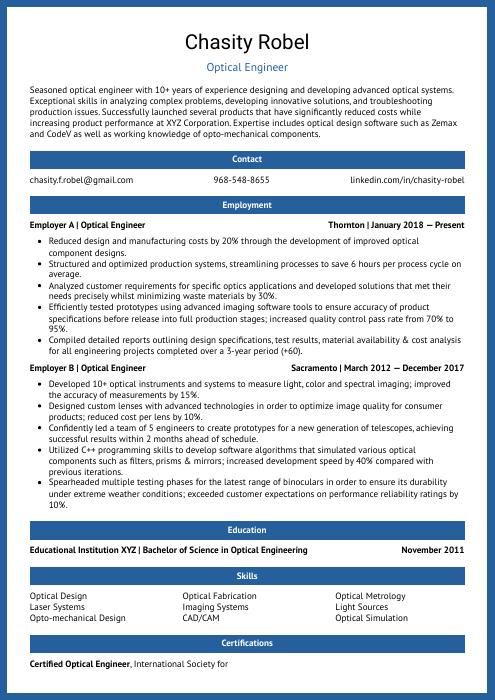 Ocelot
Ocelot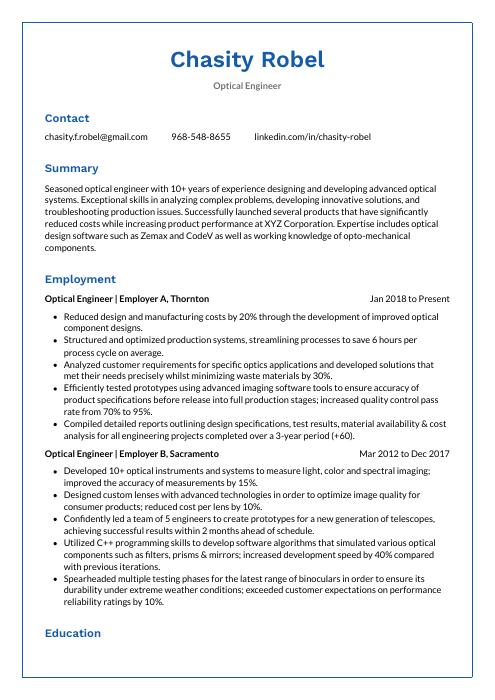 Markhor
Markhor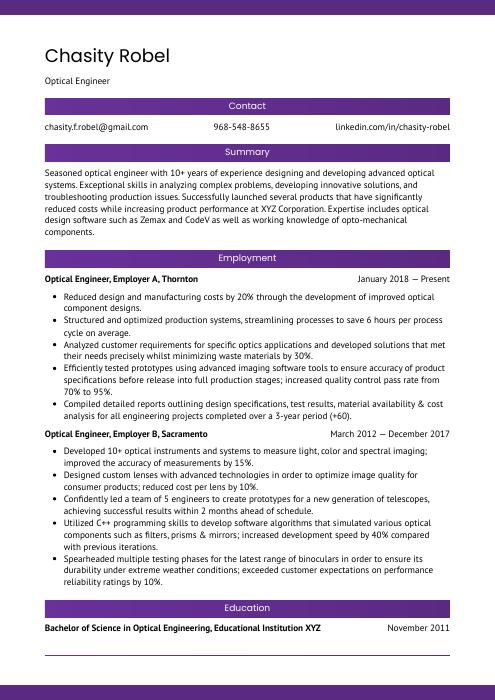 Jerboa
Jerboa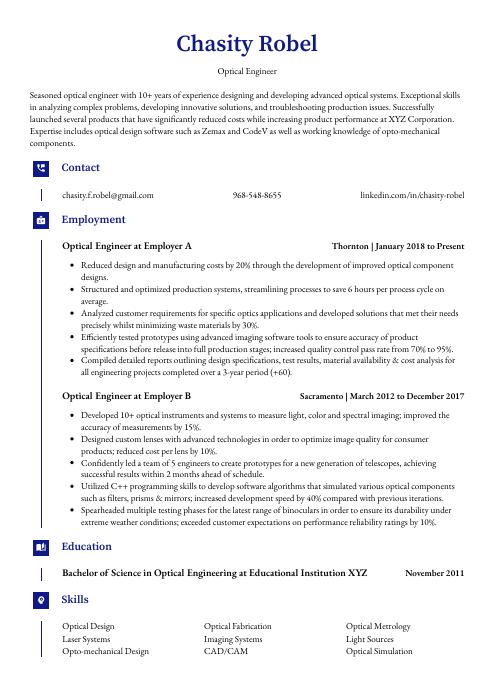 Gharial
Gharial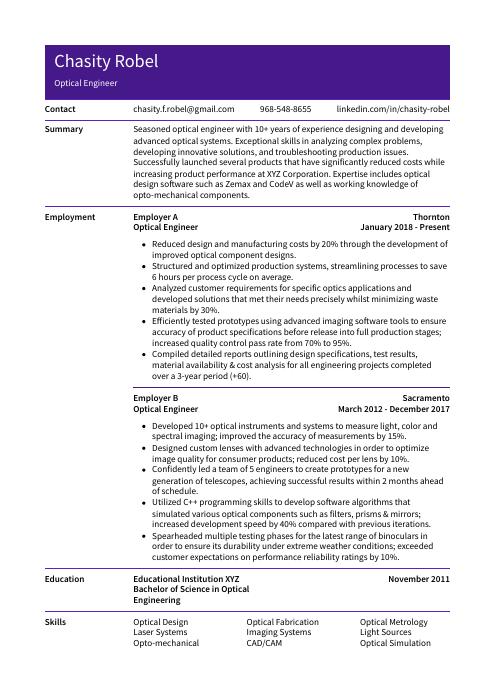 Pika
Pika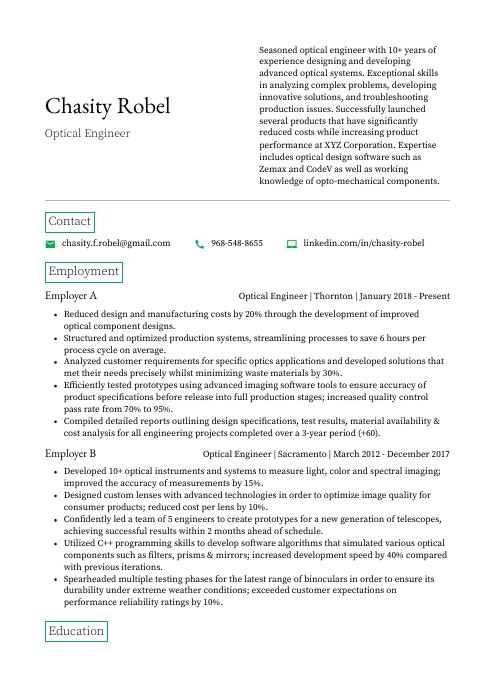 Quokka
Quokka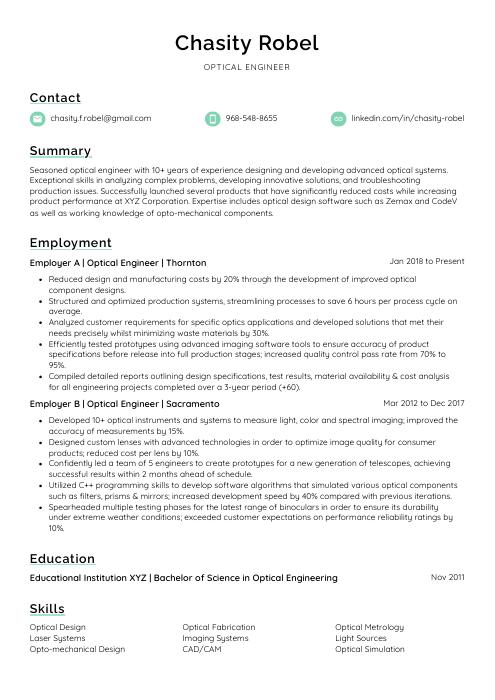 Lorikeet
Lorikeet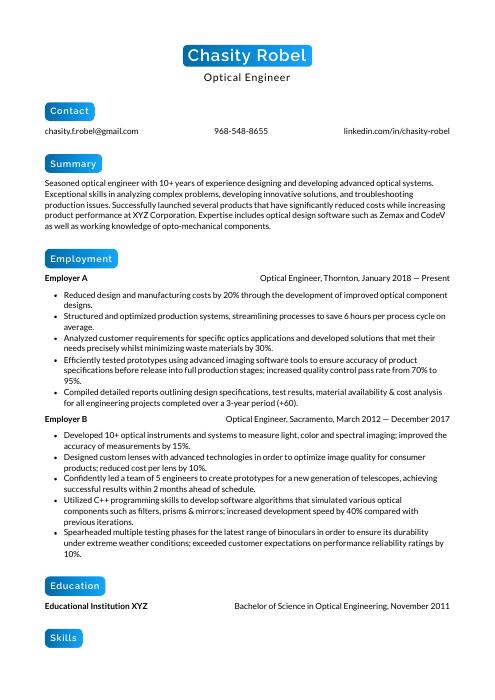 Kinkajou
Kinkajou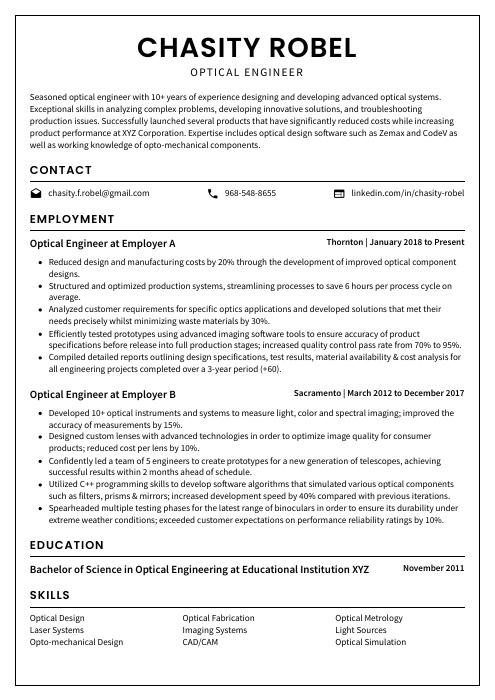 Cormorant
Cormorant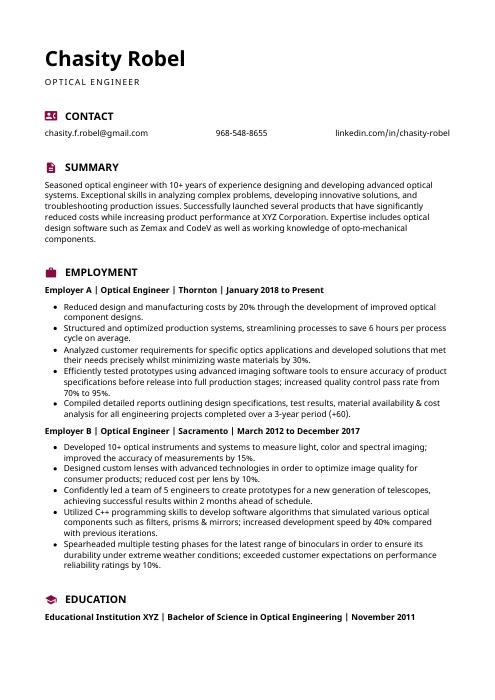 Hoopoe
Hoopoe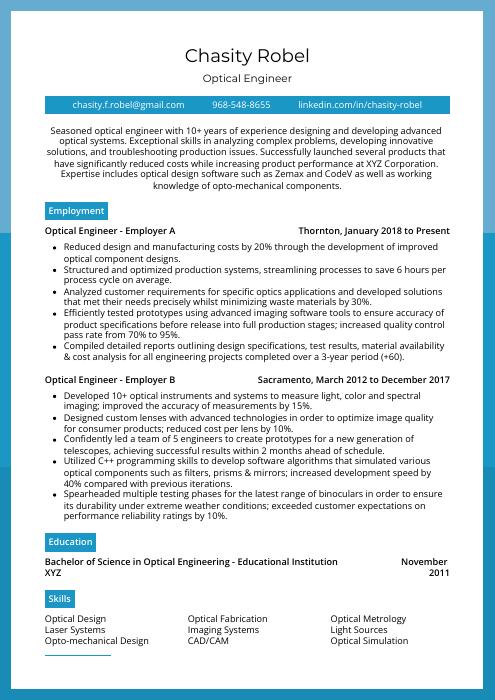 Rhea
Rhea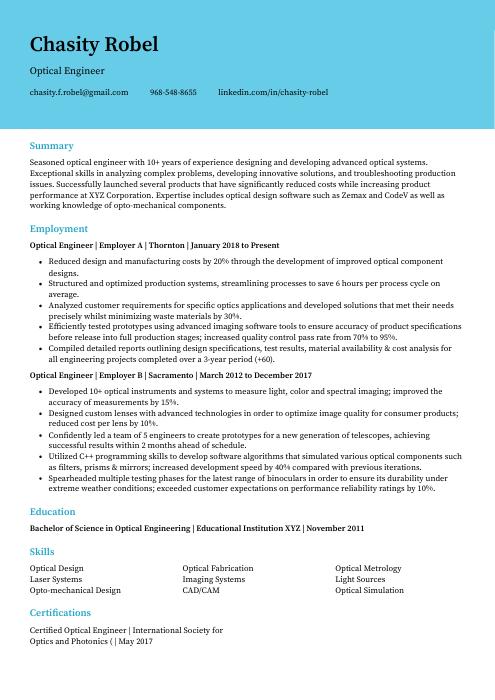 Dugong
Dugong Rezjumei
Rezjumei
